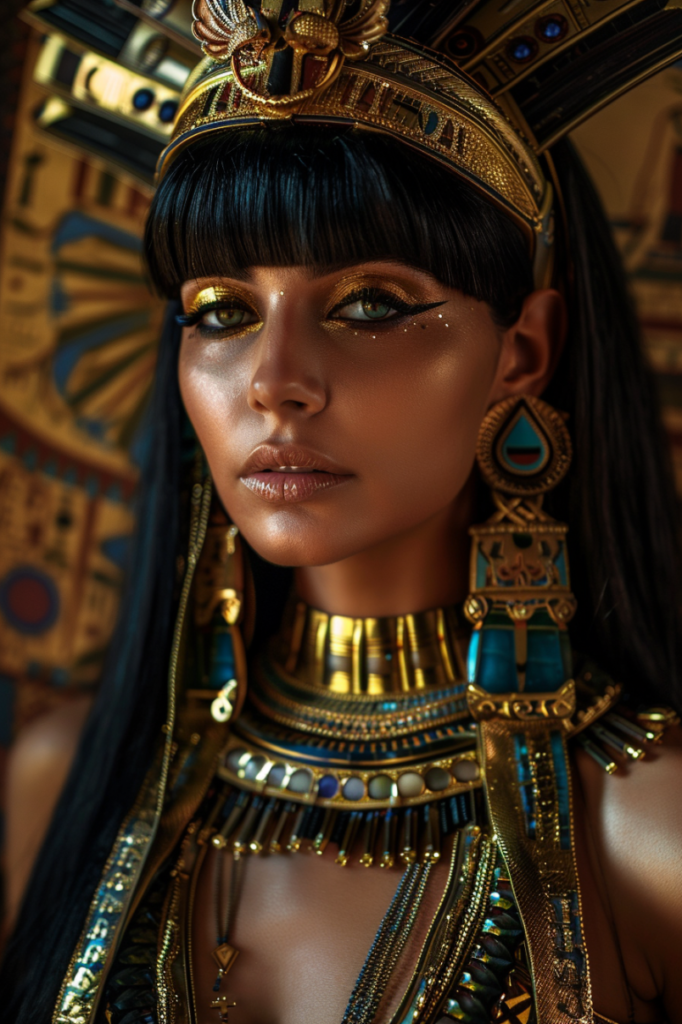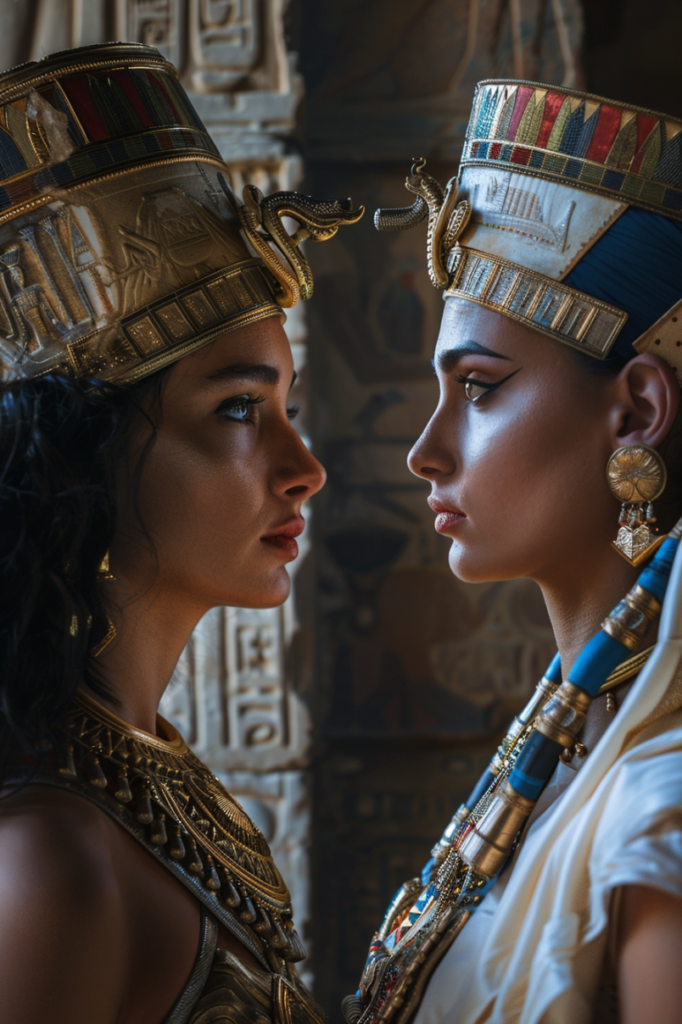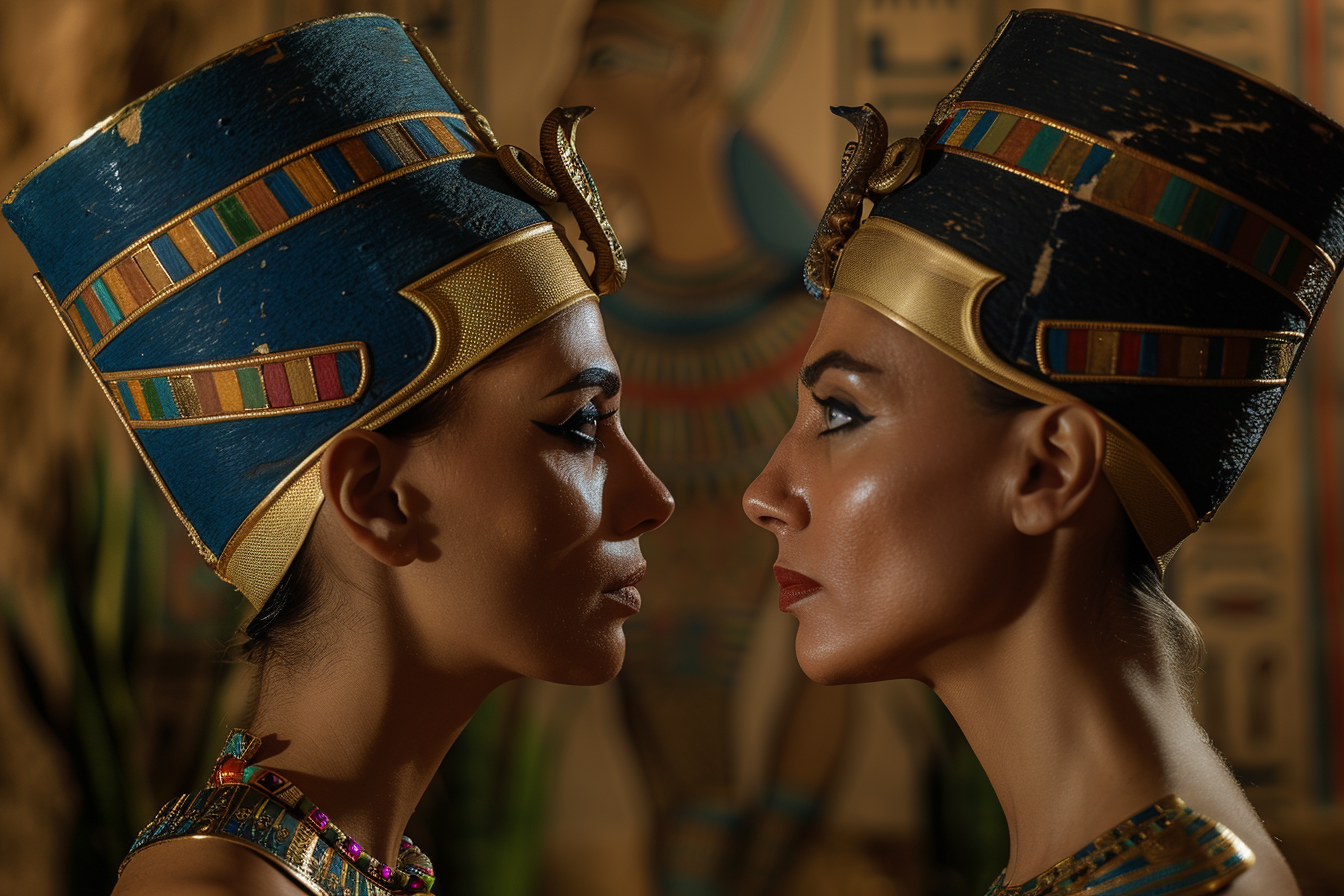
Ancient Egypt was a land of powerful pharaohs, but two women stood out among the rest: Cleopatra VII Philopator and Nefertiti.
Both queens left indelible marks on Egyptian history, but their paths to power and their legacies differ significantly.
In this article, we will delve into the lives and achievements of these two remarkable women, comparing their rise to power, political acumen, and lasting impact on ancient Egyptian society.
Cleopatra VII Philopator

Cleopatra VII Philopator, born in 69 BC, stands as one of history’s most intriguing figures.
As the final sovereign of the Ptolemaic Kingdom of Egypt, her journey to power was fraught with political upheaval and personal strife.
Early life and turmoil
Born into the royal lineage of the Ptolemies, Cleopatra was the daughter of Ptolemy XII and his sister-wife, Cleopatra V.
Her early years were shadowed by the tumultuous politics of the time, as factions vied for control of Egypt.
Upon her father’s death, Cleopatra and her younger brother, Ptolemy XIII, ascended to the throne.
However, their co-rule was marred by discord, ultimately leading to Ptolemy XIII’s demise.
Political acumen
Cleopatra’s ascendancy to power was not merely a matter of inheritance but also a testament to her political acumen.
She forged strategic alliances with prominent Roman figures, most notably Julius Caesar and later Mark Antony.
Her relationship with Caesar, both romantic and political, resulted in the birth of her son, Caesarion.
Following Caesar’s assassination, Cleopatra’s alliance with Mark Antony solidified her position as a formidable leader on the world stage.
Economic and military initiatives
During her reign, Cleopatra implemented ambitious economic and military reforms that left a lasting impact on Egypt.
She revitalized trade routes, bolstered agricultural output, and fortified the nation’s military capabilities.
Through shrewd diplomacy and calculated alliances, Cleopatra safeguarded Egypt’s autonomy amid the growing influence of the Roman Empire.
Legacy
Cleopatra’s legacy transcends her political achievements, encompassing her cultural and intellectual contributions to antiquity.
A patron of the arts, she fostered a vibrant cultural scene in Alexandria, promoting Greek literature, philosophy, and architecture.
Her enduring image as a powerful and intelligent woman has fascinated historians and inspired artists throughout the ages, cementing her status as an iconic figure in world history.
Nefertiti

Nefertiti, believed to have been born around 1370 BC, emerges as a captivating figure from ancient Egypt’s rich tapestry.
As the esteemed Great Royal Wife of Akhenaten, her story is veiled in mystery, yet her impact on the cultural and artistic landscape of her time is profound.
Life and journey to prominence
Nefertiti’s path to prominence begins with her union with Akhenaten, a pharaoh known for his revolutionary religious reforms.
While historical records about her life may be sparse compared to figures like Cleopatra, Nefertiti’s presence during the Amarna Period echoes through the annals of history.
Alongside Akhenaten, she navigated the turbulent currents of religious upheaval, leaving an indelible mark on Egypt’s cultural identity.
Role in the Amarna period
Nefertiti’s influence during the Amarna Period transcended traditional roles of queenhood.
She stood as a stalwart supporter of Akhenaten’s monotheistic vision, depicted alongside him in iconic artworks that captured her striking beauty and regal grace.
Notably, her likeness immortalized in the celebrated bust discovered in 1912 serves as a timeless testament to her enduring allure and cultural significance.
Legacy and ongoing contemplation
Nefertiti’s legacy is as enigmatic as the sands of the Egyptian desert.
Revered as a symbol of beauty and power, she continues to intrigue scholars and enthusiasts alike.
However, the true extent of her political influence and the nature of her relationship with Akhenaten remain subjects of debate and speculation.
Even amidst the passage of millennia, Nefertiti’s legacy persists as a captivating enigma, inviting exploration and interpretation by those drawn to the mysteries of ancient Egypt.
Cleopatra vs Nefertiti: A Comparison

While both queens were powerful and influential in their own right, their paths to power and legacies differ significantly.
| Aspect | Cleopatra | Nefertiti |
| Birth and Reign | Born around 69 BC, last active ruler of Egypt |
Believed to be born around 1370 BC, Great Royal Wife of Akhenaten
|
| Historical Knowledge | Well-documented life and reign |
Limited historical knowledge compared to Cleopatra
|
| Role | Played a significant political role in the Roman Empire |
Prominent figure during the Amarna Period, supported religious reforms
|
| Relationships | Formed alliances with Julius Caesar and Mark Antony |
Married to Akhenaten, depicted alongside him in artworks
|
| Legacy | Remembered as the last active pharaoh of Ancient Egypt |
Iconic image as a symbol of beauty, legacy shrouded in mystery
|
| Cultural Influence | Known for promoting Greek culture in Egypt |
Influenced Egyptian art and culture during the Amarna Period
|
Conclusion
Cleopatra and Nefertiti are two of the most famous and powerful women in ancient Egyptian history.
Their lives and achievements serve as a testament to the potential for female leadership in society.
While their paths to power and legacies differ, both queens left lasting impacts on ancient Egyptian society and continue to captivate historians and the public alike.



